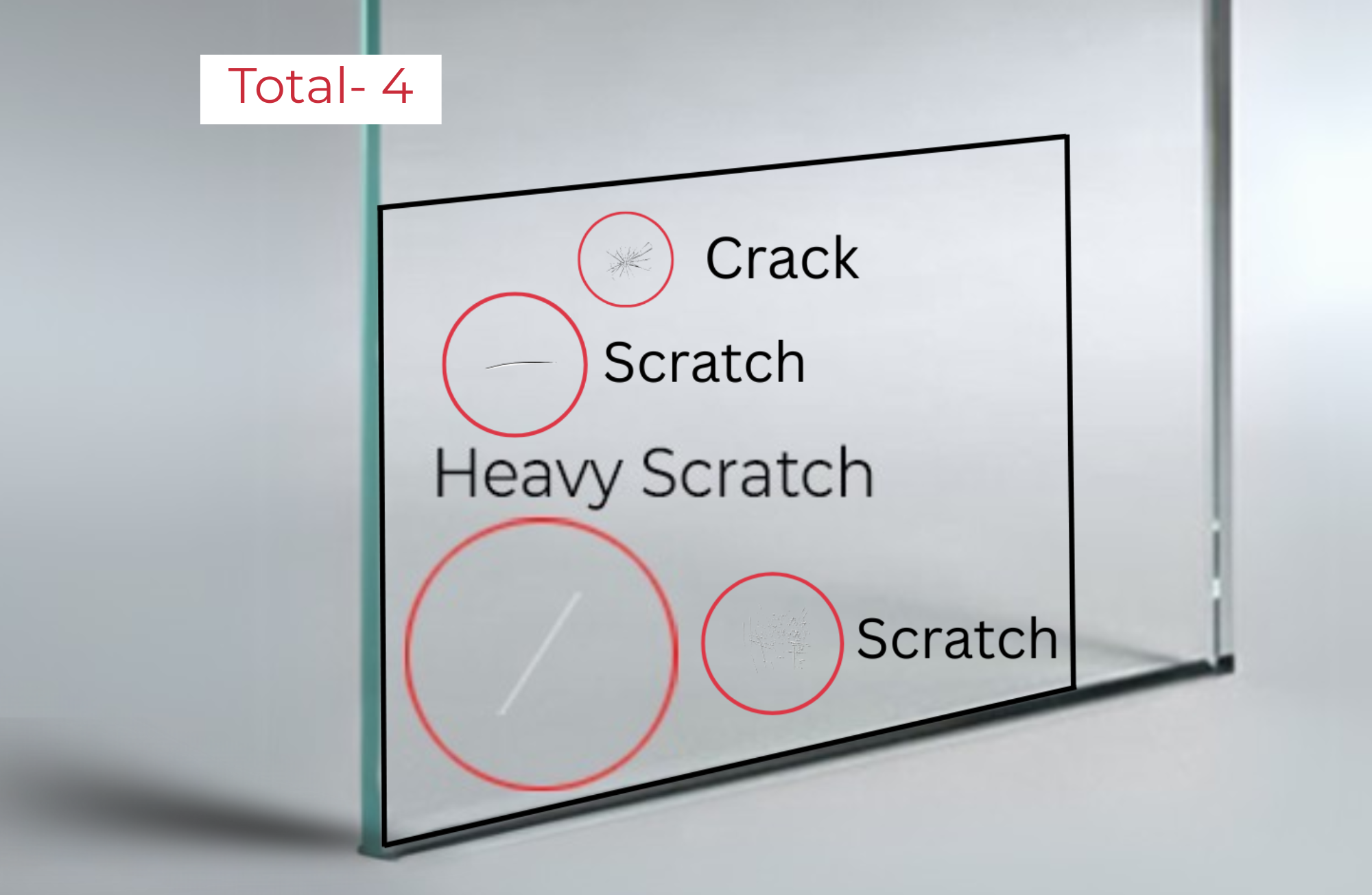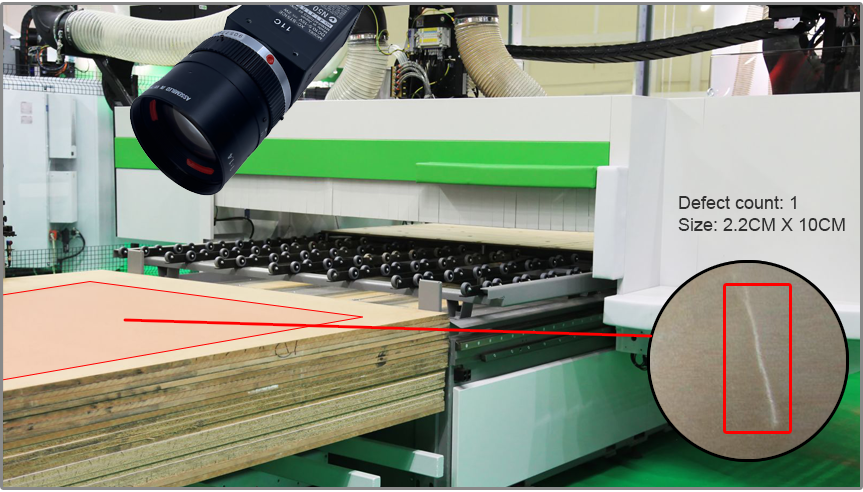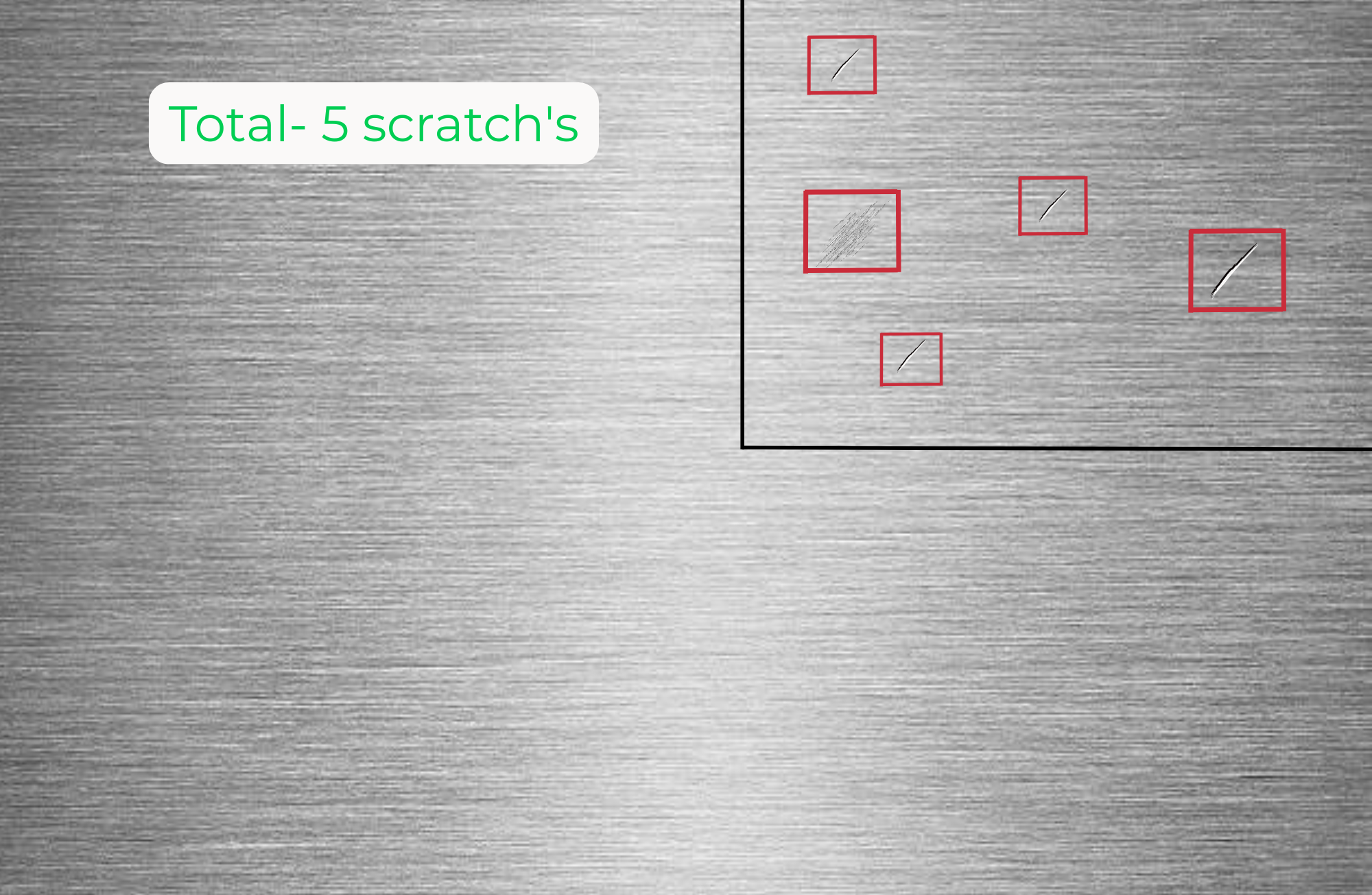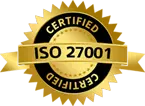Region-Based Defect Detection and Counting Using Machine Vision AI
Published on: Jun 09, 2025

Written by: Content team, Intelgic
Accurately Count Defects in Specific Areas of Your Product with Machine Vision AI
In today’s highly competitive and quality-centric manufacturing world, simply identifying the presence of defects is no longer enough. The bar for quality assurance has risen dramatically—now, it's just as important to accurately count the number of defects, particularly within specific, high-priority regions of a product. This is especially true for industries such as automotive, electronics, wood processing, glass manufacturing, and semiconductors, where production standards are exceptionally stringent. In these sectors, even the smallest imperfection—a scratch, a micro-crack, or a particle-level blemish—can carry significant weight. A few such defects might be acceptable within defined limits, but once that count crosses a critical threshold, the product may be downgraded in quality, flagged for rework, or rejected altogether. The difference between passing and failing inspection can come down to just one extra flaw—making defect counting not just a support process, but a decisive factor in product validation.

Why Defect Counting Matters
Counting defects is vital for multiple reasons:
- Product Grading: Certain grades may allow a limited number of acceptable defects. Exceeding this count—even with minor flaws—can affect the product's classification.
- Compliance and Standards: Industries follow strict quality standards that specify allowable defect counts within defined zones or critical areas.
- Customer Satisfaction: Accurate defect counting helps maintain consistency in quality, reducing customer complaints and returns.
- Root Cause Analysis: High or increasing defect counts in particular areas often indicate underlying problems in the production process, such as equipment wear, raw material issues, or environmental contamination.
- Cost Efficiency: Early detection and localized counting help reduce waste, avoid unnecessary rework, and streamline quality control operations.
Importance of Counting Defects in Specific Areas
Not all parts of a product are equally critical. For example, a minor scratch on the edge of a wooden panel may be acceptable, but the same defect in the visual center can be unacceptable. Region-based defect counting addresses this by focusing inspection efforts where they matter most.
- Localized Inspection: Targets critical zones based on product function or appearance.
- Process Optimization: Identifies patterns to guide precise repairs and adjustments.
- Smarter Decisions: Enables automated rejection or rework based on defect location.
- Higher Accuracy: Improves quality control by detecting critical flaws missed in general inspections.
- Customer-Centric QA: Aligns inspection with how the product will be used or viewed.
This granular approach ensures higher precision in quality assurance and aligns inspection with end-use criticality.

How Machine Vision AI Accurately Counts Defects in Specific Product Regions
Modern defect inspection systems rely on a seamless integration of high-performance cameras, adaptive lighting, and intelligent AI software to detect, classify, and count defects—even in microscopic detail and within defined regions of interest. Each component plays a crucial role in ensuring speed, precision, and consistency in the manufacturing process.
Machine Vision Cameras: Line Scan and Area Scan
At the heart of any machine vision inspection system are its cameras. These cameras capture the visual data required for identifying and counting defects across the surface of the product. Two primary types of cameras are commonly used:
- Line Scan Cameras
Line scan cameras capture images one line at a time as the object moves past the camera. This makes them ideal for inspecting continuous or cylindrical products such as wood panels, glass sheets, fabrics, or printed materials. These cameras offer extremely high resolution and are capable of detecting fine surface-level defects even on moving conveyor systems.
- Area Scan Cameras
Area scan cameras capture an entire frame at once, making them suitable for inspecting static or slower-moving parts. They are versatile and well-suited for applications where the entire surface can be seen in a single shot, such as small components, circuit boards, or flat surfaces that don't require motion to scan fully.
Both types of cameras can be configured to inspect specific regions of a product, allowing the system to analyze critical zones independently, ensuring that defect counts reflect the true quality impact based on location.
Advanced Lighting Techniques
Lighting is a critical part of any vision inspection system—it determines whether defects are clearly visible to the camera sensors. Advanced lighting setups are designed to enhance contrast, eliminate glare, and highlight surface anomalies that might otherwise go undetected.
Some commonly used lighting techniques include:
- Diffuse Lighting: Reduces glare and evenly illuminates the surface, ideal for shiny or reflective materials.
- Directional/Angle Lighting: Emphasizes shadows caused by surface defects like scratches, dents, or blisters.
- Backlighting: Highlights shape deformations or cracks by creating strong silhouettes.
Lighting systems are often adaptive, meaning they can automatically adjust intensity and angle based on the surface characteristics, ensuring reliable defect detection regardless of texture or material finish.
AI-Powered Software for Defect Detection and Counting
Once images are captured, they are processed using AI-driven software that analyzes every pixel to identify, classify, and count defects in real-time.
Key capabilities of the AI software include:
- Defect Classification: Identifies different types of flaws—such as scratches, cracks, blisters, or discoloration—and categorizes them based on severity and type.
- Region-Specific Analysis: Divides the product surface into defined zones and counts defects separately for each region, allowing for zone-based decisions.
- Threshold-Based Decision Making: Compares defect counts to pre-configured quality standards and automatically flags products for acceptance, rework, or rejection.
- Continuous Learning: AI models can be trained and refined over time, becoming more accurate with more data, reducing false positives and improving reliability.
By integrating with production lines, the AI software ensures real-time feedback, helping manufacturers react quickly to emerging defect trends or production anomalies.

AI-Powered Defect Counting Process
Accurate defect counting in manufacturing is achieved through an integrated system of high-speed imaging, intelligent lighting, and AI analysis. Here's how the process works:
1. Image Acquisition
High-speed line scan or area scan cameras capture detailed images of products as they move through the production line. Line scan cameras are ideal for continuous surfaces like panels and sheets, while area scan cameras work best for static or small items.
2. Lighting Control
Adaptive lighting systems enhance contrast and surface visibility by adjusting brightness and angle in real-time. This ensures that even small or subtle defects are clearly captured, regardless of surface finish or material type.
3. Region Definition
Operators can define critical inspection zones on each product, focusing on areas where defects matter most—like the visual center or load-bearing sections. This targeted approach aligns inspection with product functionality and customer expectations.
4. AI Analysis
Advanced AI and deep learning models analyze captured images to detect, classify, and assess defects by type, size, and location. The system distinguishes between acceptable imperfections and critical flaws with high precision.
5. Defect Counting & Feedback
The system automatically counts defects per region and compares them against predefined thresholds. Based on the results, it can trigger real-time actions such as product rejection, alerts, or rerouting for repair.
6. Data Logging
Each inspection is digitally logged, including defect images, counts, and outcomes. This supports traceability, trend analysis, and ongoing process improvements across production lines.
Key Advantages of AI-Based Defect Counting
High Accuracy and Repeatability:
AI-powered machine vision systems deliver exceptionally precise defect detection and counting, far surpassing human capabilities. By consistently applying the same inspection criteria, these systems eliminate variability and ensure repeatable results across every product, reducing errors and improving quality assurance.
Scalability Across Product Lines:
These intelligent inspection solutions are highly adaptable and can be scaled to accommodate a wide variety of products and manufacturing processes. Whether inspecting small electronic components or large wood panels, the system can be customized to different sizes, shapes, and defect types—making it versatile for diverse production environments.
Real-Time Decision-Making:
With instant analysis and defect counting, the system enables real-time quality control decisions on the production line. This rapid feedback loop helps manufacturers quickly identify issues, reduce downtime, and prevent defective products from progressing further, boosting overall operational efficiency.
Faster Than Manual Inspection:
Automated machine vision and AI operate at speeds that far exceed manual inspection capabilities. This increased throughput allows manufacturers to maintain high quality standards without compromising production speed, ensuring timely deliveries and competitive advantage.
Supports Predictive Maintenance Through Defect Pattern Recognition:
By continuously monitoring and logging defect data, AI systems can identify recurring patterns and anomalies that signal potential equipment wear or process deviations. This predictive insight enables proactive maintenance, minimizing unexpected breakdowns and optimizing production uptime.
Applications of Region-Based Defect Detection and Counting in Various Industri
1. Textile Industry: Detection of holes, stains, and weaving defects in specific fabric zones.
2. Automotive Industry: Identification of paint defects, surface scratches, and weld flaws in targeted vehicle body sections.
3. Electronics Industry: Inspection of PCBs for missing components, soldering defects, and micro-cracks in defined regions.
4. Wood and Furniture Manufacturing: Detection of knots, cracks, and surface irregularities in wooden panels or furniture surfaces.
5. Packaging Industry: Identification of misprints, seal defects, and structural anomalies in designated package areas.
6. Metal and Steel Industry: Surface inspection for rust, dents, and cracks on defined sections of metal sheets or coils.
7. Pharmaceutical Industry: Capsule or tablet defect detection (e.g., chipping, discoloration) within specific tray or blister pack regions.
8. Food Processing: Identifying deformities, discoloration, or contamination in selected zones of food products or packaging.
Intelgic: Pioneering AI-Driven Surface Inspection
Intelgic stands at the cutting edge of AI-driven visual inspection technology, delivering solutions that transform how manufacturers monitor product quality. Through its innovative Live Vision AI software, Intelgic enables precise defect counting within specific, targeted regions of any product, allowing for highly focused and meaningful quality assessments.
By integrating advanced imaging technologies, including high-resolution machine vision cameras and adaptive lighting systems, with sophisticated AI models customized for each product type, Intelgic’s platform ensures inspection processes that are not only fast but also exceptionally accurate and reliable. This tailored approach allows manufacturers to confidently detect even the smallest defects where they matter most.
Intelgic’s system offers a range of powerful features to enhance manufacturing quality control:
- Zone-Based Defect Mapping
Accurately identifies and counts defects within defined regions, enabling granular analysis aligned with product function and customer expectations.
- Custom Defect Thresholding Per Region
Allows manufacturers to set specific quality limits for different areas, supporting flexible and precise acceptance criteria.
- Cloud-Based Reporting and Analytics
Provides comprehensive, real-time data visualization and historical trend analysis, accessible anytime and anywhere, empowering informed decision-making.
- Seamless Integration into Existing Production Lines
Designed for compatibility with current manufacturing setups, ensuring quick deployment without disrupting ongoing operations.
Whether inspecting wooden panels, electronic components, or automotive parts, Intelgic equips manufacturers with cutting-edge tools to elevate quality control standards. The result is reduced downtime, minimized waste, improved production efficiency, and ultimately, greater customer confidence in the final product.

